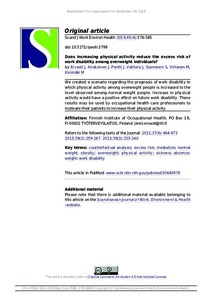Does increasing physical activity reduce the excess risk of work disability among overweight individuals?
Airaksinen J; Pentti J; Kivimaki M; Virtanen M; Vahtera J; Suominen S; Ervasti J
Does increasing physical activity reduce the excess risk of work disability among overweight individuals?
Airaksinen J
Pentti J
Kivimaki M
Virtanen M
Vahtera J
Suominen S
Ervasti J
SCANDINAVIAN JOURNAL WORK ENVIRONMENT & HEALTH
Julkaisun pysyvä osoite on:
https://urn.fi/URN:NBN:fi-fe2021042612025
https://urn.fi/URN:NBN:fi-fe2021042612025
Tiivistelmä
Objectives We examined the extent to which an increase in physical activity would reduce the excess risk of work disability among overweight and obese people (body mass index >= 25kg/m(2)).Methods We used counterfactual modelling approaches to analyze longitudinal data from two Finnish prospective cohort studies (total N=38 744). Weight, height and physical activity were obtained from surveys and assessed twice and linked to electronic records of two indicators of long-term work disability (>= 90-day sickness absence and disability pension) for a 7-year follow-up after the latter survey. The models were adjusted for age, sex, socioeconomic status, smoking, and alcohol consumption.Results The confounder-adjusted hazard ratio (HR) of long-term sickness absence for overweight compared to normal-weight participants was 1.43 [95% confidence interval (CI) 1.35-1.53]. An increase in physical activity among overweight compared to normal-weight individuals was estimated to reduce this HR to 1.40 (95% CI 1.31-1.48). In pseudo-trial analysis including only the persistently overweight, initially physically inactive participants, the HR for long-term sickness absence was 0.82 (95% CI 0.70-0.94) for individuals with increased physical activity compared to those who remained physically inactive. The results for disability pension as an outcome were similar.Conclusions These findings suggest that the excess risk of work disability among overweight individuals would drop by 3-4% if they increased their average physical activity to the average level of normal-weight people. However, overweight individuals who are physically inactive would reduce their risk of work disability by about 20% by becoming physically active.
Kokoelmat
- Rinnakkaistallenteet [19207]
